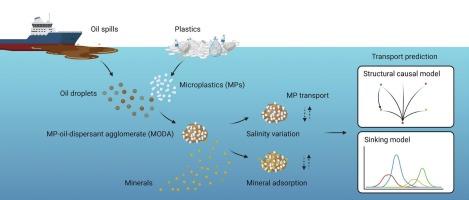Prediction of microplastic transport in oil-contaminated waters
IF 4.9
3区 环境科学与生态学
Q1 ENVIRONMENTAL SCIENCES
引用次数: 0
Abstract
Microplastics (MPs) are pervasive in marine environments and pose potential risks to marine ecosystems. MPs can transport from the surface to the deep layers, raising concerns about their impact on vulnerable deep-sea species. Scientists believe MPs are present in oceans around the world. Recent studies on the application of oil spill treating agents at sea have shown that MPs can interact with oil in the presence of chemical dispersants to form MP-oil-dispersant agglomerates (MODAs). To advance our knowledge on the behavior and transport of MPs, this study investigated the distribution of MPs under different salinities and mineral concentrations in oil-contaminated marine environments. Results indicated that the presence of oil and chemical dispersants promoted the downward transport of MPs. Minerals significantly enhanced the sinking of larger MPs through adsorption. A causal analysis identified specific surface area (SSA) as the dominant factor influencing MP transport in oil-contaminated marine environments. Model predictions further revealed that sinking velocity increased with agglomerate size and density. Our findings provide important experimental data to support the development of predictive MP transport models that are needed for environmental risk assessments and the selection of the most appropriate oil spill response measures in oil-contaminated waters.

石油污染水域微塑料迁移预测
微塑料在海洋环境中普遍存在,对海洋生态系统构成潜在风险。MPs可以从表层传播到深层,这引起了人们对它们对脆弱的深海物种的影响的担忧。科学家认为,MPs存在于世界各地的海洋中。最近关于海上溢油处理剂应用的研究表明,在化学分散剂存在的情况下,MPs可以与石油相互作用,形成mp -oil-分散剂团聚体(MODAs)。为了进一步了解MPs的行为和运输,本研究对石油污染海洋环境中不同盐度和矿物浓度下MPs的分布进行了研究。结果表明,石油和化学分散剂的存在促进了MPs的向下运输。矿物通过吸附作用显著促进较大MPs的下沉。因果分析表明,比表面积(SSA)是影响石油污染海洋环境中MP迁移的主要因素。模型预测进一步表明,沉降速度随团聚体大小和密度的增加而增加。我们的研究结果提供了重要的实验数据,以支持预测MP运输模型的发展,该模型用于环境风险评估和选择最合适的石油污染水域溢油响应措施。
本文章由计算机程序翻译,如有差异,请以英文原文为准。
求助全文
约1分钟内获得全文
求助全文
来源期刊

Marine pollution bulletin
环境科学-海洋与淡水生物学
CiteScore
10.20
自引率
15.50%
发文量
1077
审稿时长
68 days
期刊介绍:
Marine Pollution Bulletin is concerned with the rational use of maritime and marine resources in estuaries, the seas and oceans, as well as with documenting marine pollution and introducing new forms of measurement and analysis. A wide range of topics are discussed as news, comment, reviews and research reports, not only on effluent disposal and pollution control, but also on the management, economic aspects and protection of the marine environment in general.
 求助内容:
求助内容: 应助结果提醒方式:
应助结果提醒方式:


